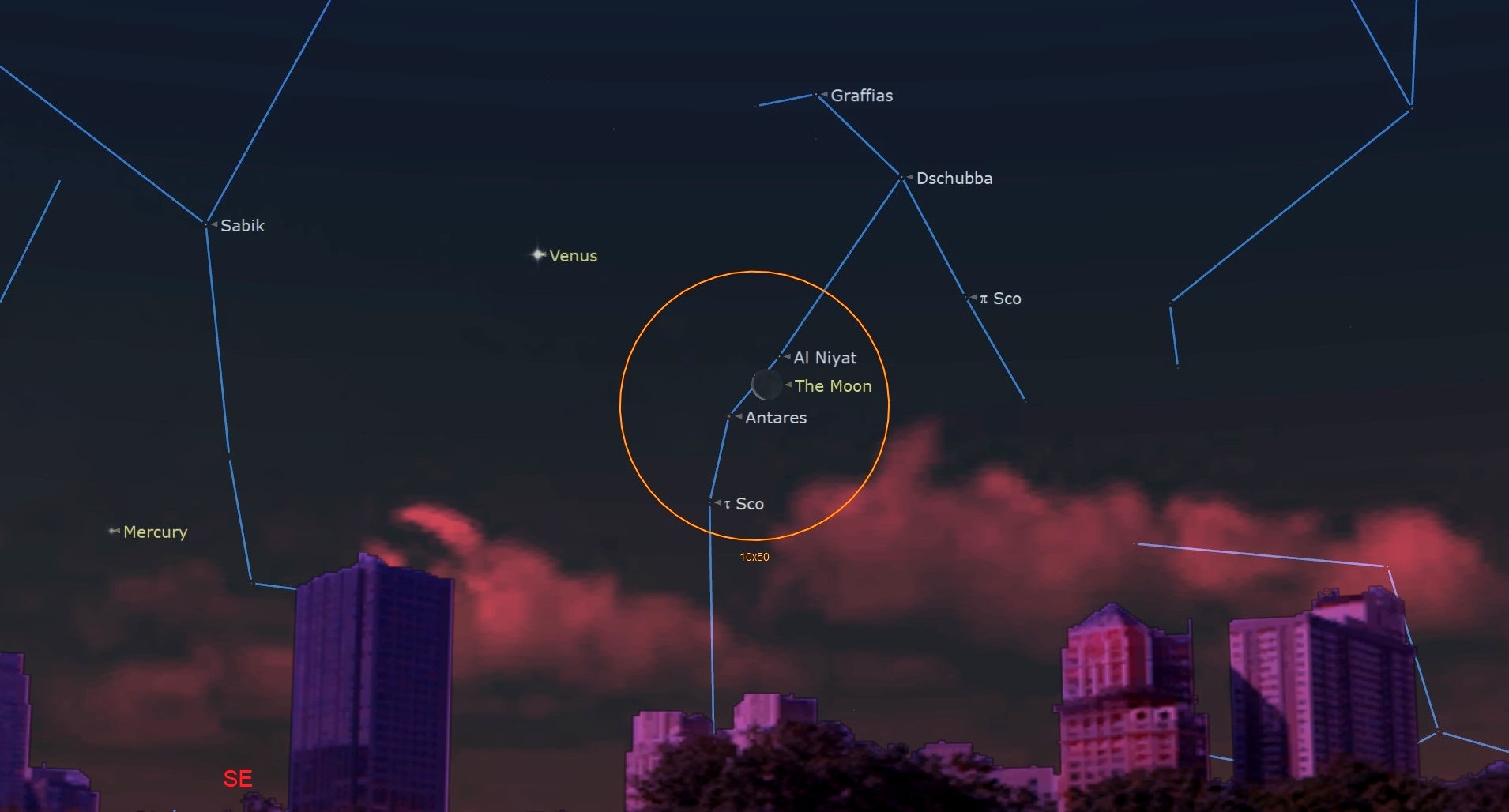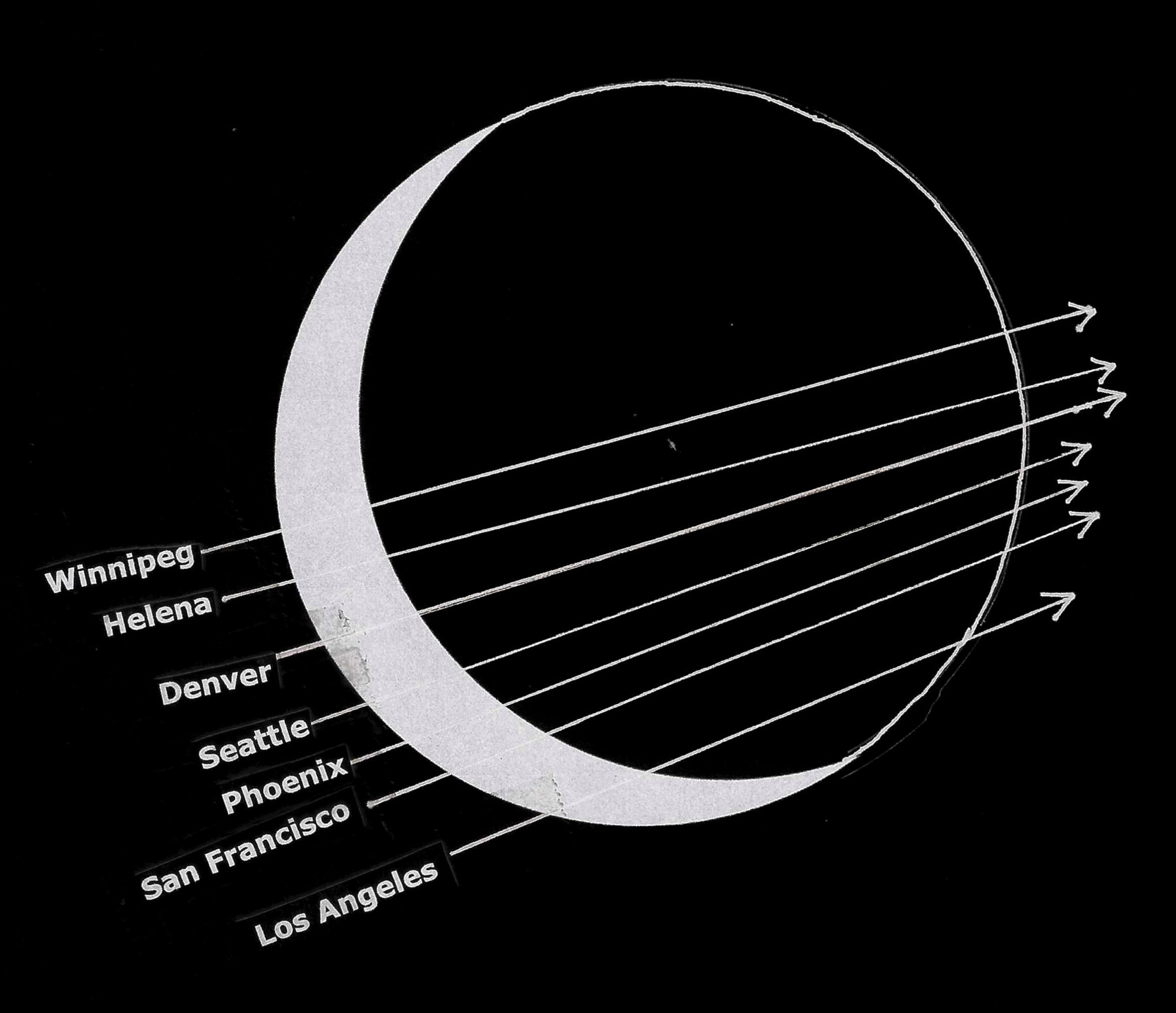Watch red supergiant star Antares pass behind the moon early on Jan. 8

As the moon makes its monthly circuit around the sky it often passes in front of stars, blotting them out for as much as an hour or so.
Such an event is called an occultation (derived from the Latin word occultāre, which means "to conceal."), and it can be a startling spectacle, especially if the star happens to be bright. The star appears to creep up to the moon's limb, hangs on the edge for a minute or two, and then, without warning, abruptly winks out. Later it pops back into view just as suddenly on the moon's other side. The suddenness with which occultations take place was one of the first proofs that the moon has no atmosphere. If our natural satellite were cloaked with an atmosphere, a star approaching its limb would appear to fade away gradually, just like one seen setting beyond the western horizon from here on Earth.
If you live in the Pacific or Mountain Time Zone, make sure to set your alarm clock for before sunrise on Monday, Jan. 8, for early on that morning a waning crescent moon, 11% illuminated, will occult the 1st-magnitude red supergiant star Antares, one of the brightest stars in the sky. This should be well worth rousing yourself out of bed in the dawn hours to watch if you live in one of the far-western states.
Unfortunately for those who live farther east, across the central and eastern states, this stellar eclipse occurs after sunrise in a bright daytime sky. From these regions, Antares will appear very close to the lower left of the moon as they slowly ascend the east-southeast sky pre-sunrise. But as they gradually draw closer, the increasingly bright twilight sky will ultimately overwhelm Antares before the moon gets a chance to hide it.
Related: Night sky, January 2024: What you can see tonight
Region of visibility
For westerners, the action begins when Antares disappears behind the moon's bright limb. For those living in the Northwestern States the moon will be barely above the horizon, so poor seeing will compound the problem. From Seattle, for instance, the disappearance of Antares comes right after moonrise.

Looking for a telescope for the next lunar occultation? We recommend the Celestron Astro Fi 102 as the top pick in our best beginner's telescope guide.
Farther south, the moment of disappearance will appear higher. From San Francisco the pair will be 6 degrees high and from Los Angeles they'll be 11 degrees above the horizon. (Your clenched fist held at arm's length measures about 10 degrees in width.) Moon and star will make a striking sight as the latter disappears near the south cusp of the lunar crescent.
Breaking space news, the latest updates on rocket launches, skywatching events and more!
Since Antares will disappear behind the moon's bright limb, binoculars or a telescope will probably be needed to watch this event.
However, those same Northwestern states, as well northern California will be in excellent position to see the star's reappearance, which will be spectacular wherever the moon is up in a dark sky; an event more readily observable, because the moon will be higher above the horizon and the star won't be washed out by the crescent's bright glare. For most of Washington, Oregon, the northwest corner of Nevada and the northern third of California, morning twilight will have already begun, yet the sky will still be quite dark when Antares springs back into view from behind the moon's dark edge. Its sudden emergence should be able to be seen with the unaided eye if you have good vision. Binoculars will pull the star in well, and a small telescope will afford a superb view.
Those living as far east as a line running from roughly southernmost California to southeast Montana will see Antares emerge during bright morning twilight; the farther east you go, the brighter the sky will get. For those who live east of a line running from about southeast Arizona to northwest South Dakota, Antares will unfortunately reappear after sunrise. Nonetheless, the moon should still be visible and provided that it is not too hazy, a good telescope should also bring out Antares as a tiny speck against the blue sky.
A "wily companion"
Adding even more interest to this event for those who will be watching under a dark sky is Antares' 5th-magnitude companion star, which was discovered from Vienna, Austria by Professor Johann Tobias Bürg during the Antares occultation of April 13, 1819. Since this faint secondary star is 2.7 arc seconds due west from Antares, it will always reappear five seconds before Antares itself. (To appreciate how small 2.7 arc seconds is, the moon's apparent width averages 1,800 arc seconds in diameter. So, Antares and its companion are separated by 1/667 of a moon diameter, or 0.00075-degree!). American astronomer, Mary Proctor (1862-1957) referred to it as "the wily companion of Antares."
The companion star has been described as appearing emerald green or a "verdant hue" as compared to the ruddy glow of Antares. But the upcoming occultation will present a rare, albeit brief chance to gauge the companion's true color free of any contrast illusions. Back in Feb. 1991, I had a chance to see the faint companion emerge from behind the Earth-lit edge of a waning crescent moon and judged it to be a pale blue-white in color. What color will you see on Jan. 8?
The disappearance of the companion will be invisible, since it occurs between the glare of Antares and that of the moon's bright limb.
What to expect
In the table below, we provide viewing circumstances for seven selected cities, giving times for when Antares disappears behind the bright edge of the moon ("in") and when it will pop back into view from behind the moon's Earth-lit dark edge ("out"). The time of sunrise is also provided. Note that from Phoenix, Denver and Winnipeg, Antares will emerge after sunrise.
| Location | Time zone | In | Out | Sunrise |
|---|---|---|---|---|
| Seattle, WA | PST | 5:36 a.m. | 6:40 a.m. | 7:56 a.m. |
| San Francisco, CA | PST | 5:37 a.m. | 6:27 a.m. | 7:25 a.m. |
| Los Angeles, CA | PST | 5:40 a.m. | 6:29 a.m. | 6:59 a.m. |
| Phoenix, AZ | MST | 6:40 a.m. | 7:42 a.m. | 7:33 a.m. |
| Helena, MT | MST | 6:41 a.m. | 7:51 a.m. | 8:11 a.m. |
| Denver, CO | MST | 6:43 a.m. | 7:58 a.m. | 7:21 a.m. |
| Winnipeg, MB | CST | 8:01 a.m. | 9:09 a.m. | 8:24 a.m. |
Also provided, is a chart showing the path of Antares as it goes behind the moon. The star disappears behind the bright crescent, while it will reappear behind the Earth-lit dark edge. For those in the Far West looking for the early emergence of Antares companion star, concentrate on that part of the moon's disk where the companion and, five seconds later, the far brighter Antares will appear.
Next time?
If unsettled weather prevents you from getting a view of this "Antares eclipse," there are two more chances to see another during the next several months, however in both cases, the viewing zone will be confined to primarily to the Piedmont and Southeast Coastal regions, as well as Florida and parts of Gulf Coast. The first case involves a last quarter ("half") moon on March 3 and, like our upcoming event this week, will again occur during the early hours of the morning. The other case will take place during the more convenient late evening hours of May 23, but the moon will be practically full.
Antares occultations occur in a series, which started on Aug. 23, 2023 over much of North America, and will continue each month over various parts of the globe until the current series comes to an end on Aug. 27, 2028 over Central Asia.
If you are hoping to catch a look at Antares, lunar occultations or any other night sky sight, our guides to the best telescopes and best binoculars are a great place to start.
And if you're looking to snap photos of the lunar occultation of Antares or the night sky in general, check out our guide on how to photograph the moon, as well as our best cameras for astrophotography and best lenses for astrophotography.
Joe Rao serves as an instructor and guest lecturer at New York's Hayden Planetarium. He writes about astronomy for Natural History magazine, the Farmers' Almanac and other publications.

Joe Rao is Space.com's skywatching columnist, as well as a veteran meteorologist and eclipse chaser who also serves as an instructor and guest lecturer at New York's Hayden Planetarium. He writes about astronomy for Natural History magazine, Sky & Telescope and other publications. Joe is an 8-time Emmy-nominated meteorologist who served the Putnam Valley region of New York for over 21 years. You can find him on Twitter and YouTube tracking lunar and solar eclipses, meteor showers and more. To find out Joe's latest project, visit him on Twitter.


